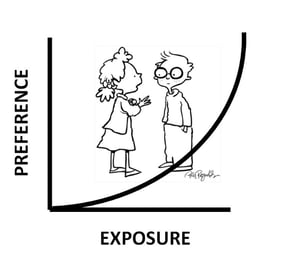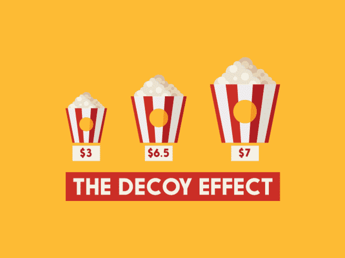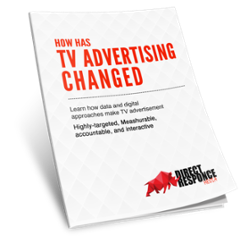Cognitive biases refer to how the brain commonly responds in seemingly irrational ways in response to how information is presented.
These mental shortcuts have their basis in emotion rather than rationale. As the unconscious works at a far faster pace than the conscious part of the brain, people rely on these shortcuts when making a decision.
Luckily for marketers, these responses are predictable. By understanding each pattern of thinking and how people’s cognitive biases affect their perception and decision making, marketers will be far better informed to create advertising that appeals to the way that the brain works in order to drive conversions.
1. Anchoring
When people see the original price for a product in comparison to the sale price, the original price serves as a benchmark in their minds for what the product or service is worth, so anything lower feels like they are winning and getting a bargain. This explains why people feel the need to buy things at a sale price that they don’t need.

Dan Ariely (2006) conducted a study whereby participants were asked to write down the last two digits of their Social Security Number. Ariely then held up items and asked the participants to bid for them. He found that people with high SSN digits paid up to 346% more in the auction than those with low digit numbers. As the first number they saw, their SSN digits had unwittingly become their benchmark and influenced how much they were willing to pay.
Anchoring is used to great effect in direct response TV ads that offer a limited-time discount while displaying the original price and the saving that the customer will receive. The urgency in this call to action together with the limited timescale urges the consumer to take advantage of the offer immediately. Their brain isn’t thinking in terms of needing the product or service that they are purchasing. They are thinking in terms of the money that they will save, not realising that they would have saved more if they had not fallen for anchoring hook, line and sinker!
2. Framing Effect
The way that people react to advertising depends on whether it is presented as a loss or a gain. This insight came from psychologists Tversky and Kahneman (1981) who presented study participants with the exact same information, first in a positive way and then in a negative way.

They were told that 600 people had a deadly disease and given two treatment options: A and B. When Treatment A was presented as saving 200 lives, 72% of participants opted for it, but when it was presented that 400 people would die if they chose Treatment A, just 22% people went for that option.
The wording of your copy will have a big impact in how your product or service is presented in people's minds and the associations that they will have when they think of it.
3. The Rhyme-as-Reason Effect
One of the most well-known examples of this cognitive bias is the memorable line that helped acquit O.J. Simpson: ‘If it doesn’t fit, you must acquit.’ The certainty of how rhyme fits together helps to present something as factual information in people’s minds.
 Psychologist, Matthew McGlone, PhD., (2000) tested this theory by providing students with a list of rhyming and non-rhyming couplets. The students felt that the rhyming statements were more truthful than the non-rhyming statements.
Psychologist, Matthew McGlone, PhD., (2000) tested this theory by providing students with a list of rhyming and non-rhyming couplets. The students felt that the rhyming statements were more truthful than the non-rhyming statements.
He also found that when the same information was presented first in non-rhyming and then in rhyme form, the rhyming statement suddenly made that information seem more plausible. In one example, he asked his students whether people would become healthier after becoming financially successful, to which almost all of them disagreed. When he presented the rhyming statement, ‘wealth makes health’, all of a sudden, his students agreed with the statement.
Incorporating rhyme into your advertising provides an easy way for the memory to store the information for brand recall. It will also have a persuasive effect as the brain perceives two statements as being interlinked simply because the last two symbols make the same sound.
4. The Picture Superiority Effect
People find it easier to recall images than words. This is because the brain processes visual information at a far quicker pace - in just a quarter of second, in fact - than any other type of stimuli. Our brains have evolved from a world before text existed, where survival was dependent on the brain quickly assessing whether its daily encounters posed a threat, and these survival instincts still remain today.

Our brains actually process text as individual images, so when looking at an advertisement, the brain is processing hundreds of letters and forming it into sequences to make sense of how the letters combine to make words and sentences. In the meantime, the accompanying visual image has already been processed, encoded and committed to memory, as it requires far less effort for the brain to comprehend.
Dr John Medina (2008) conducted a study that found that when participants were presented with information orally, they were only able to recall 10% of the information three days later. When a visual image was included, the recall rate rose to 65%.
As engaging visuals create an emotional connection, they add more depth to the encoding of information, making it easier for the brain to commit it to memory. This makes using visuals in your advertising a more powerful way to generate brand recall than text or sound alone. A radio advertising campaign supported by TV advertising or an outdoor campaign will strongly reinforce brand recall in people's minds.
5. Negativity Bias
Another bias that has survived from our sabre-toothed cat dodging days is a sensitivity to negativity. Unpleasant news and emotion make a bigger impact on people than positive news, causing them to dwell on it for longer. This sensitivity evolved as a means of protection to quickly alert people to things that would be harmful.

John Cacioppo, one of the founders of social neuroscience, showed participants a range of images designed to generate positive emotions, like pizza, images that would arouse negative feelings, such as a dead animal and images that would not stimulate an emotional reaction, like a plate, while recording their brain activity. He found greater electrical activity when people viewed the negative stimuli.
Advertisers can capitalise on the brain’s tendency to respond more strongly to negative emotion by drawing attention to the negativity that could arise if people don’t respond to the advertisement: the images of poverty would continue if they don’t make a donation, for example.
6. Social Validation
People may be wary of advertisers’ tall claims of what they can offer but when you throw in testimonials by regular people, people can identify with them and it provides a reassuring sense of confirmation that to make a purchase would be the right decision. By adding more testimonials, this effect is intensified.

Advertisers should ensure that their testimonials come from people who fit their target demographic as people will feel an even stronger level of trust and identification with people just like them.
Social validation comes from our desire to fit in with society. It has evolved from a time when not conforming to the social group’s behaviour and beliefs meant certain ostracism, rather than an ensured chance of survival. When people are faced with a decision and are not sure what to do, they automatically look to other people’s opinions to inform their decision and allow the opinions of others to shape their own perceptions.
7. Peak-End Rule
People remember an experience based on how their heightened emotions felt at their peak and also the enduring feeling that they felt at the end.

Fredrickson and Kahneman (1993) showed two groups of study participants a range of film clips that contained both pleasant and unpleasant emotions. They asked the first group to rank how they felt while watching the film clips and the other group to later recall in retrospect how they felt while watching them. Each time, participants broke the film clips down into snapshots of how they felt both at their emotional peak and at the end of the film to determine how they felt overall about the film clips. The length of the film clips varied but that did not affect this pattern of recall.
These findings can be applied to advertising of any length to ensure that the message that you want prospective consumers to take away is reinforced at the end of the advertisement. This is particularly effectively achieved in the call to action of a direct response message. In addition, it is important to heighten the emotion that you want people to associate with your product or service as a feeling will be easier to encode and recall. If it makes them feel good, they will want to replicate that feeling.
8. Conjunction Fallacy
Also known as the Linda problem, due to its famous example, this pattern of reasoning reveals that when we are provided with more specific information in a statement, we believe it more likely to be true than a more general statement. The Linda example provided by Tversky and Kahneman (1983) presented study participants with two statements: 1. Linda is a bank teller and 2. Linda is a bank teller and is active in the feminist movement. The participants were asked which of these statements was more likely to be true and between 85-90% of them picked option 2.

By including extra details in your advertising to further illustrate what your product or service provides, people are more likely to believe it to be true, as it paints a more vivid picture in their minds.
9. Attentional Bias
Attentional bias refers to our tendency to pay attention to some, but not all, stimuli. This evolved from an evolutionary need for our ancestors to take stock of the most important information that they were presented with, in order to quickly judge the best decision, to ensure survival. They would focus their attention on the threats before the positive stimuli.

Marketers can play on people's instinctual need to respond to a threat first by implying a sense of urgency, such as a limited-time only sale. This is a surefire way to grab their attention.
10. Bandwagon Effect
People feel the need to fit in with everyone else. Once again, this bias evolves from a survival instinct; if our ancestors didn’t share the opinion of the social group, they would have been outcast which would have been a very dangerous predicament to be in!

People also want to feel that they are right. They assume that if everyone else is buying something, they can’t all be wrong; there must be something really superior about it. As more and more people follow suit for this reason, it only seems right to do the same.
By including stats of how many people have already bought into your brand and pitching yourself as the most popular option, people will feel a need to conform to the behaviour of the masses. The bandwagon effect is particularly effective in digital marketing where the number of 'likes' is on display.
In fact, a study by Egebark and Ekström (2011) revealed that the more Facebook likes something has, the more people feel inclined to ‘like’ it too. They posted the same statement three times: once with a ‘like’ by an unknown user, another with ‘likes’ by three unknown users and another with one ‘like’ by a peer of the study participants.
One ‘like’ by an unknown user did not have any effect, but the other two statements resulted in twice the number of positive responses. The study revealed that not only are people influenced by groups but that they also place great weight on what their peers are doing. This is why encouraging word-of-mouth referrals is an important factor of business growth, as people trust their friends’ opinions.
11. Mere Exposure Effect
People experience preferences for things that they are familiar with. The mere exposure effect reveals that the more we are exposed to something, the more we like it. Building brand awareness is something that takes time but it will pay in dividends when it results in long-term business growth. By advertising through multiple mediums, you will increase familiarity and create a warm feeling of recognition.

Robert Zajonc (1968) conducted experiments which proved the mere exposure effect. In one of his experiments, he showed participants symbols resembling Chinese characters which didn’t actually have any meaning attached to them. The participants were shown each of the characters between 0 and 25 times and asked to rate how they felt about them. The participants attached a more positive meaning to the characters that they were shown at a higher frequency.
12. Decoy Effect
By displaying the price of your product or service alongside another worse example, you will heighten the positive illusion of your offer in people’s minds. In his book, Predictably Irrational, Ariely showed how The Economist used this sales technique to boost sales.

First, they gave buyers two subscription choices: a year’s subscription to their website articles for $59 and a year’s subscription to both the printed edition and the website for $125. 68% of buyers opted for the $59 offer and 32% chose the $125 offer.
The Economist then added a decoy to the mix: a third option of a year’s subscription to the print edition for the same price of $125. Suddenly, this framed the combined offer of print and the website for the same price as a bargain in people’s minds. As a result, just 16% of buyers opted for the $59 offer, no-one took out a subscription for the print offer alone but 84% of buyers bought the print and online package for $125!
13. Primacy Effect
When given a list of things to remember, consumers find it easiest to recall whatever they see or hear first. Their attention spans are more focused at the start, before they start internally processing the information that they are being presented with. In addition, they assume that whatever is placed first must be of highest importance. This can be demonstrated by people assuming that whatever result is at the top of search engine rankings must be the most important one even if it is a pay per click ad.

Asch (1946) demonstrated this by describing the same person to two different groups of people, using the exact same adjectives, but in a different order. For the first group, he described the man as intelligent, industrious, impulsive, critical, stubborn and envious. For the second group, he reversed the order of words, describing him as envious, stubborn, critical, impulsive, industrious and intelligent. When asked to rate the man, the first group rated him far higher due to the fact that intelligence was their prominent impression of him. Therefore, advertisers need to be strategic with the information that they present first.
14. Recency Effect
The recency effect places importance on the message and emotion that people are left with at the end of an advertisement. The brain focuses on the beginning and end of the message, skimming over the information in the middle. The information that people heard most recently is retained in the short-term memory, so it is important to make an impact with your final statement. In a direct response advertisement, this is the time to make your call to action shine!
The primacy and recency effect are also important when considering the position of your ad placement. The first ad at the start of TV and radio ad breaks and the last ad before the show resumes are the prime spots in which to place your TV and radio advertisements. These are the moments when more people are still giving the TV and radio their full attention.
15. Loss Aversion Bia
As a marketer, you can heighten this bias by illustrating the negative things that people could encounter in their lives unless they use your product or service, which promises to take those possibilities away. Presenting your product or service in terms of what people would lose if they don’t buy it, rather than what they would gain if they do buy it, will make a big difference to their response.

Just as data analytics provides measurable data to inform our media buying decisions, neuroscience provides measurable data from within people’s brains to inform creative decisions. At Direct Response Media, we place importance on measuring both data to optimise each aspect of the media placement and creative to continually increase ROI for our clients.
As Melbourne's leading marketing agency, we use the latest neuromarketing techniques to create winning marketing strategies for our clients. Get in touch to find out how we can help you to hone your creative using neuromarketing.




